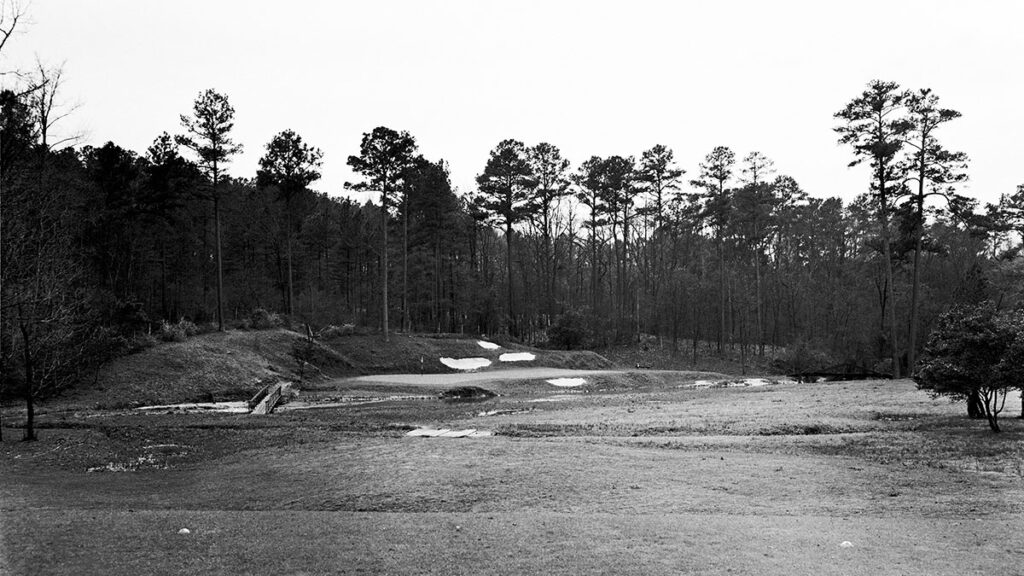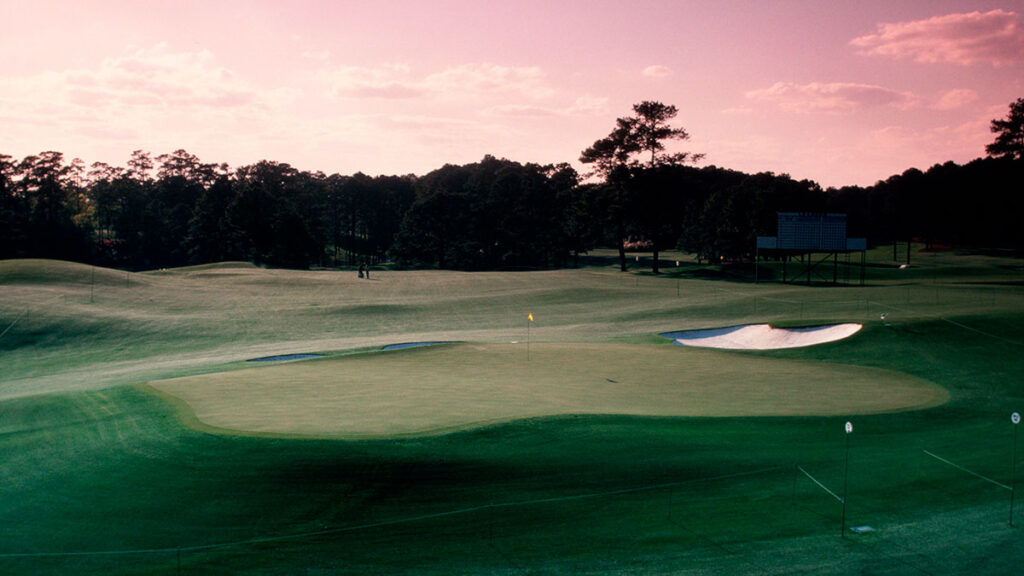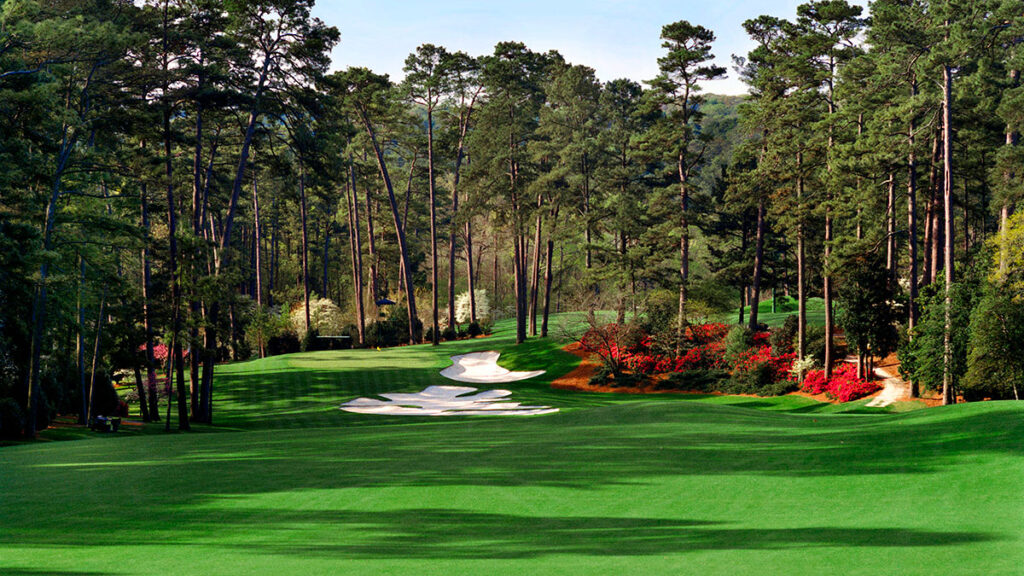The course has evolved continuously since the first Masters in 1934. Which version was the best? (Hint: It’s not now).
One of the peculiarities of Augusta National is how little the club’s alterations impact the perception of the golf course. Improvements have taken place nearly every offseason since the inaugural Masters in March 1934, from greenside modifications to major reconfigurations of different holes. Intended to keep the course relevant for the contemporary professional game, many of these changes have gradually mutated the course’s appearance and historical design concepts. Yet despite Augusta National’s evolving character, it continues to be perceived as a monolithic entity. In Golf Digest’s ranking of America’s 100 Greatest Golf Courses, Augusta National has slipped outside the top 10 just once since 1966 and has been a fixture in the top three each year since 1985.
The Augusta National of 2024 is like the Augusta National of 2004 to the same degree that the course of 1974 is like the course of 1934, which is to say not very much. Slice into Augusta at any given point on its timeline and the presentation and playability will be unique. It begs the question, was there a moment when the club came the closest to an ideal presentation? Is it possible to pinpoint a time when the symbiosis of shot demands, hole lengths, fealty to the intended strategies, playing conditions and club and ball technology were in perfect harmony? In other words, if we were to enshrine one version of Augusta National in the Golf Course Hall of Fame, which year would it be?

1930-’40s: UPHEAVAL OF A FOUNDATIONAL DESIGN
6,700-6,800 yards
Average winning score: 281 (-7)
Lowest winning score: 279 (Ralph Guldahl, 1939; Claude Harmon, 1948)
Many architecture purists would argue for Alister MacKenzie and Bob Jones’ original 1932 idea of an inland course that emulated the shots and strategic concepts of St Andrews, with wide fairways allowing for preferred but risk-laden lines of attack into steeply contoured greens. As engaging as the founding design might have been, making the case for early Augusta National would be difficult because of the turf conditions of the 1930s.
As with most southern golf courses, Augusta National was planted with Bermuda grass, which goes dormant in the winter. When dormant Bermuda grown on clay soil dries out (Augusta is built on clay), it gets rock hard. When it’s wet – and south-eastern winters and early springs are notoriously rainy – it becomes soppy and almost unplayable. Tom Watson recalls Byron Nelson telling him it was common for clover to be growing in the fairways. Even after overseeding greens and fairways with cold-tolerant perennial rye, a practice the club still endeavours each autumn to provide a grassy cushion and deep green colour, course conditions would have been irregular and at the mercy of Mother Nature in an era of limited underground drainage and primitive fertilisers and herbicides, as well as irrigation.
Nor were Jones and club chairman Clifford Roberts satisfied with the design from a competition perspective: the first major course revision happened almost immediately with the swapping of the nines after the 1934 tournament (the current 10th was originally the first). Before the 1938 and 1939 Masters, architect Perry Maxwell made significant alterations to the seventh, ninth, 10th, 12th and 14th holes, among others. The carousel had begun to turn.
The 1940s were a decade of upheaval. After victories by Jimmy Demaret, Craig Wood and Byron Nelson, the course sat fallow during World War II when the Masters was suspended for three years, grown over and essentially turned to pasture. After the war, the club engaged Robert Trent Jones to oversee another series of alterations, including the creation of the longer, modern 11th hole with an enlarged water feature next to the green and the new par-3 16th cocked 90 degrees from the old and playing across a broad pond.

1950-’70s: AN EQUABLE TEST COMES INTO ITS OWN
6,900-7,040 yards
Average winning score: 281 (-7)
Lowest winning score: 271 (Jack Nicklaus, 1965; Ray Floyd, 1976)
By the early 1950s, Augusta National had essentially matured into the grounds we recognise now, even down to the blue dye in the ponds, added for the first time in 1951. The decades between then and the late 1970s represent a halcyon period of relative stability when the course consistently measured about 6,950 yards, 250 yards longer than when it opened, putting it in the same weight class as US Open stalwarts like Oakmont, Oakland Hills, Oak Hill, Inverness and Winged Foot. Despite hole-to-hole fluctuations, this distance remained roughly intact through the end of the 1990s.
Because club and ball technology advanced slowly during this time, Augusta National’s hole lengths and shot demands were in balance with equipment. Driving distances did not change much, and there remained continuity between the types of shots Sam Snead and Ben Hogan hit and those of Jack Nicklaus and Tom Watson. Holes like five, 10, 11, 13, 15 and 18 required controlled long irons or woods into the greens, followed by spin control on shorter shots and putting touch on what were considered among golf’s fastest greens, even if they were honey-drip slow by today’s expectations (a USGA study in 1977 determined their Stimpmeter speed was just seven feet, 11 inches compared to an estimated 13 feet or higher now). From 1950 to 1979, the average winning score was 280.6 (7.4-under in relation to par), including record-breaking years of 271 by Nicklaus (1965) and Raymond Floyd (1976), only a stroke lower than 1934 to 1949 (281.7).
Course conditions had improved since the 1930s and ’40s, but many of the same problems persisted. The turf was the best the players competed on each year, but the surfaces were still primitive compared to contemporary standards, and the quality of the fairways continued to be determined by the elements. Warm temperatures in February and March might foster early Bermuda growth that enhanced the ryegrass lies, but in normal or colder years the Bermuda remained stunted, and the rye could be sparse, patchy or muddy. “You didn’t know what they would be from year to year,” Nicklaus told The Augusta Chronicle in 2016. “In 1965, I shot a [then tournament-record] 17-under-par. In 1966, I won a playoff after shooting 288. That’s 17 shots higher, and the difference was the fairways.”
The Bermuda-based greens were also hard and difficult to hold with long second shots. Players rarely dominated the par 5s like they do now. “I was always long enough to reach the par 5s, but I couldn’t keep it on the greens,” Floyd told Golf Digest. “I was coming in with 2 and 3-irons, but the greens, because they were Bermuda grass, were too firm. I used a 5-wood in 1976 because I could hit it high and soft, and I ran away with the tournament.”

1980-’90s: THE GREENS GET SCARY GOOD
7,040-6,985 yards
Average winning score: 279 (-9)
Lowest winning score: 270 (Tiger Woods, 1997)
Even if course conditions were ideal for the era, no version of Augusta National could reasonably contend for “best” before 1980, the year the greens were converted to bentgrass. This change, with the use of improved strains of rye overseed in the fairways, moved the course into the current period of agronomy and aesthetics, including manicured bunker edges. During the early ’80s, some of the greens were almost unplayable because the slopes were too severe for the higher speeds of the bentgrass.
“On No.9 in the final round when I won in 1981,” Watson remembers, “I hit the ball just over the back edge of the green. As soon as I putted it, I started walking and putting my glove back on because I knew it was going to go right off the front of the green.”
As the bent greens matured, they became increasingly grippy as well, so much so that shots routinely began spinning off greens. “You used to play a long iron to 18 and have it bounce a couple of times and stop,” Tommy Aaron said during the 1986 Masters. “Now you hit a 2-iron and it can come right back down the hill at you.”
The faster bentgrass greens required players to modify their games and forced the club to adjust the greens, softening contours on holes like four, six, eight, nine, 14 and 18. “You couldn’t breathe on the ball or it would take off and roll off the green,” Hale Irwin said. “Now you can at least breathe on it.”
The final piece of Augusta National’s maintenance matrix was put into place in the 1990s when Marsh Benson, the director of golf course and grounds, invented a subsurface air-circulation system, now known as SubAir, that aerified the rootzone and could vacuum water from the playing surfaces. The system greatly improved green-to-green consistency – helping fix perennial problem greens like the par-3 12th, located on the lowest, coolest part of the property – and gave Augusta National unparalleled control over the playing surfaces.

2000s and 2010s: ‘TIGER-PROOFING’ BEGINS
6,985-7,475 yards
Average winning score: 278 (-11)
Lowest winning score: 270 (Jordan Spieth, 2015)
Until the early 2000s, the modifications the club had made over the previous 50 years were primarily about adapting to developing turf and maintenance breakthroughs. By 2002, the alterations became more defensive. Average driving distances on the PGA Tour increased by more than 22 yards between 1980 and 2001. Even more concerning, the average winning score between 1990 and 2001 was 276.3, four strokes lower than the average winning score the previous 40 years (280.6).
The 15th hole is a useful barometer for understanding how the distance gains provoked Augusta National to embark on the most consequential architectural changes since the 1950s. Until 2002, the demands of the second shot to the 15th green, played downhill and over a water hazard, had changed little since Gene Sarazen knocked a 4-wood into the hole for an albatross in 1935. Players almost always had 220 to 230 yards remaining after good drives, putting them in position to contemplate trying to reach the tabletop green with long irons or woods. During the final round of the 1975 Masters, Nicklaus had about 235 yards to cover the water and chose to hit his 1-iron, which settled 12 feet from the hole. Eleven years later in 1986, Nicklaus played a 4-iron from 200 yards to the flag (the hole measured 20 yards shorter than in 1975) setting up a historic eagle. En route to his 1998 victory, Mark O’Meara played a 3-iron from 220 yards, leading to the first of three birdies over the final four holes.
By the mid-2000s, players were driving the ball much longer. After the hole was lengthened to 530 yards in 2006, drives continued to yield approach shots in the 200 to 210-yard range, often just 5 and 6-irons. By the late 2010s longer hitters were looking at second shots well under 200 yards, notably Sergio Garcia’s Sunday 176-yard 8-iron in 2017.
To counteract the driving distances, Augusta National added 520 yards between 1999 and 2006. It has since extended the course an additional 100 yards, bringing the official total to 7,545. More consequentially the club began to place a greater premium on accuracy off the tee by narrowing the holes, initially by adding a “second cut” of rough in 1999. “We felt that we could no longer let them swing from the heels,” said then Masters chairman Hootie Johnson. The second cut did little to affect scoring. “You could argue it wasn’t what Bobby Jones and Alister MacKenzie had in mind,” says Ernie Els, “but it didn’t bother me as much as it bothered some people.”
“I still say the golf course is harder when it was mowed wall to wall because the errant shot went down in creeks and down into the trees and into the pinestraw,” says Floyd. “The rough stops the ball going into bad places. You don’t make 8s and 9s after that like you could in the past.”
The efforts to enforce accuracy intensified between 2002 and 2011 when groves of mature pines were planted on holes like seven, 11, 15, 17 and 18 in areas that were formerly fairway. The right-side driving option on 11, for instance, was entirely removed, eliminating an angle into the green that some players preferred. No matter how effective the measures have been in protecting the perceived sanctity of the course, the narrowing was a blow to the founding MacKenzie-Jones-St Andrews philosophy of Augusta National, where the greens and hole locations were expected to extract punishment for wayward play, not trees and longer grass. “You’ve just got to plod along,” Tiger Woods said in 2008. “It’s playing more of a US Open than it is a Masters.”
2020s: POWER REIGNS SUPREME
7,475-7,545 yards
Average winning score: 275 (-13)
Lowest winning score: 268 (Dustin Johnson, 2020)
We’ve just entered this era, so we’ll keep our assessment brief. Augusta National can direct round-to-round scoring to some degree through hole locations and green firmness, but the club has continued to add distance. It’s now unlikely anyone but the longest hitters can compete over four rounds. In the 2023 Masters, 31 of 86 participants averaged 300 yards or more off the tee (including those missing the cut), and more than half averaged 295 yards or more. The average driving distances of the top eight finishers from each of the past four Masters are 304.8, 308.5, 300.2 and 304.4 yards, respectively. Also, the past six winners have all been double-digits under par, the longest streak in Masters history.
The ‘Greatest’ Augusta National
Where does that leave the discussion of which Augusta National belongs in the Hall of Fame? The club’s maintenance prowess and ability to control the playing surfaces would bolster an argument that the course has never been better. Conversely, the pure length has put the green jacket out of reach for perhaps half the field, making it improbable that crafty feel players like past champions Ben Crenshaw, Seve Ballesteros, Jose Maria Olazabal or Gary Player could contend. The narrowing of numerous fairways has eliminated an important degree of decision-making that was always critical to scoring well. Crenshaw summed it up best in 1986, comparing Augusta’s cerebral calculations to more penal courses like TPC Sawgrass. “At Augusta, it is strategy, strategy, strategy,” he said. “Augusta’s strength is around the greens and the ability to place tee shots according to the pin locations.” Now, on too many holes, the prevailing criteria is to just get the ball in the fairway, exactly Crenshaw’s critique of the TPC.
If not the 2000s, 2010s or now, then when? Any decade like the 1950s that drew out the best from champions like Jimmy Demaret, Sam Snead, Ben Hogan, Cary Middlecoff and Jackie Burke Jnr deserves consideration. From 1960 to 1966, no player won the Masters who wasn’t Arnold Palmer, Jack Nicklaus or Gary Player. The Augusta National of this period demanded an array of shots through the bag, risk-taking and nerve, but inconsistent conditions and the hard Bermuda greens of the era would preclude selection of any iteration of the course before the 1981 tournament.
The 1980s were a fascinating decade, a Golden Age of European talent that saw a variety of skillsets capable of navigating Augusta and its sleeker greens, including Ballesteros, Bernhard Langer, Sandy Lyle, Nick Faldo and, in 1991, Ian Woosnam, along with Watson, Crenshaw, Craig Stadler, Nicklaus and Larry Mize. Turf conditions, however, had not consistently reached the utopian levels they would in the next decade and beyond – there was still ample room for improvement.
That places the debate in the mid-to-late 1990s, after the club had begun installing the SubAir systems (1994) and approaching maintenance nirvana, but before the addition of the “second cut” of rough that looked awkward and deviated from Augusta’s heritage. Our choice for Augusta National’s most ideal version is the course of 1995 to 1998. Before the severe lengthening, any type of player might still contend. Surrounding Tiger Woods’ record-setting 18-under-par victory in 1997 were wins by 43-year-old Crenshaw (1995), a 38-year-old Faldo (1996) and 41-year-old O’Meara (1998). Though driving distances were increasing, the architecture remained an apt foil for the spinny, wound golf balls and smaller metal-head drivers of the time, and players still needed to play long irons and woods into the par 5s (and even some par 4s), illustrated by Faldo’s minutes-long deliberation between his 5-wood and 2-iron for the second shot at 13 after he had tracked down Greg Norman in 1996.
Some say that MacKenzie, who died in 1934, wouldn’t recognise Augusta National if he saw it today. He probably wouldn’t with the altered holes, razored bunker edges, imported groves of pines, Perry Maxwell’s greens and the immaculate turf. But if he were transported to 1998, it’s likely he would appreciate the course for rewarding a spectrum of physical and tactical skills, a course that required bravery, guile and experience as much as power. That, at least, was the Augusta National he believed he and Jones had designed.
Photos by: Augusta National/Getty Images



